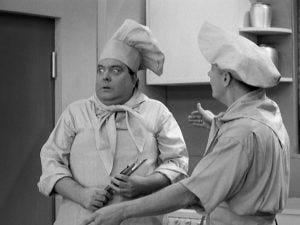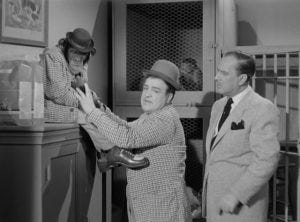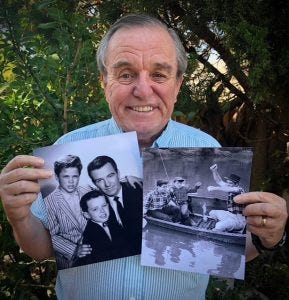Sunday Morning Coffee — June 19, 2022 — Father Knows Best
Father’s Day was so different when we were kids, wasn’t it? Hallmark hadn’t gotten their marketing claws into us yet commercializing the celebration. Back then, in the 60s, a typical Dad’s Day centered around being home. For us, we might have tossed a baseball with Dad, sat in the backyard under the weeping willow tree and maybe even get my brothers off the hammock long enough to take a swing. Then, late in the afternoon came the main event: Dad would open the huge bag of Kingsford charcoal briquettes, his hands soon blackened, fire up that cylinder makeshift grill and then came the burgers, dogs and corn on the cob. Mom wouldn’t let us touch the corn until we had, fittingly enough, those corny holders sticking out the sides. It was all chased by giant slices of watermelon. Idyllic.
And then that night, in fact almost every night, an important part of our days as kids was sitting in the den, Mom puffing on a Parliament, Dad a Winston, together watching the television shows that were such a big part of our youth. I had so many favorites the list seemed to be endless: Clark and Lois, Bud and Lou, Ralph and Norton, Wally and the Beaver. For me, it was great television. We never knew anything about ‘backstories’; we accepted what we saw as gospel. So, on this gorgeous U.S. Open Father’s Day in the desert, let’s peel back the curtain of some of our staples and learn what we didn’t know when the cameras stopped running:
The Adventures of Superman (1952-58, 104 episodes). The production was ultra-low budget. The cast wore the same outfits in every episode. The series may never have made it if Kellogg’s didn’t step in as a sponsor in 1952. In fact, the characters did commercials for the cereal that aired with each episode. Except for Lois, as it was deemed by censors to be too sexually provocative to suggest she and Clark would eat a morning meal together. George Reeves’ original costume, in the monochromatic broadcasts, was brown, gray and white. In seasons three through six, 1955-58, the show was shot in color but didn’t air in color until the reruns in 1965, which was about the time we got our first color television set; we used Superman’s costume to adjust the red and blue hue. Early in the series, kids were putting on a cape and jumping off houses thinking it could make them fly. In 1955 Reeves filmed a series of public service announcements reminding children that, “No one, but no one, can do the things Superman does. And that goes especially for flying!” Only the keenest eye would later recognize that in Superman’s first season, 1952, the Metropolis set was actually what later became Mayberry.

Ralph forgot his lines and the Handy Housewife Helper skit went awry.
The Honeymooners (1955-56, 39 episodes). The original Alice, Pert Kelton who played in the first seven episodes, was fired because her husband, Ralph Bell, was allegedly a communist. That opened the door for the great Audrey Meadows. However, she was rejected initially because Jackie Gleason thought she was “too young” and “too pretty” to be his TV wife. Ms. Meadows wouldn’t take no for an answer and the next day had a photographer take photos of her with no makeup and her hair not styled. Gleason had no idea she was the same woman he rejected the day before. He said that was the Alice they were looking for. Ms. Meadows was also the only cast member to receive residual payments from the Honeymooners re-runs for the rest of her life. Her brothers were attorneys and had it written into her contract. The network didn’t oppose it, never thinking the show would be as successful as it became. Gleason was instrumental in the cancellation of the brief series believing after 39 episodes they used all the story lines and jokes they had and didn’t want the show struggling for material. The Kramden’s very modest apartment was modeled after the Brooklyn tenement in which Gleason grew up. It has been well documented that Gleason did not like rehearsing and wanted lines to be spontaneous. He believed in only one script run-through before filming live. Meadows, Art Carney and Joyce Randolph didn’t necessarily buy that concept and rehearsed on their own. When Gleason is seen patting his stomach in an episode, that was an indication he had forgotten some lines and needed his co-stars to ad-lib and stall so he could catch-up. Best remembered for that was the great episode “Better Living Through TV” aka the “Handy Housewife Helper” when Gleason blew the sketch and it eventually fell apart during taping. Ms. Randolph, Trixie, was afraid of Gleason on set because his drinking, coffee with whiskey, would alter his mood and according to her, he became problematic to work with. There was virtually no off-set relationship amongst the cast.
The Andy Griffith Show (1960-68, 249 episodes). In season one, Andy and Barney were referred to as cousins. That relationship changed going forward in season two. Francis Bavier, Aunt Bee, had a very chilly off-set relationship with Andy. Word was that Bavier did not like working with Griffith. In fact, the story goes that in 1972, four years after the show concluded, Griffith and Ron Howard went to pay her a visit at her home in Siler City, NC, but she turned them away. When the series ended in 1968 because Andy was mentally and physically exhausted, the show was number one in prime time. The only other network shows to end on top were I Love Lucy and Seinfeld. Don Knotts was paid $1250 an episode to be Barney and Ron Howard, $1000 an episode, to play Opie. Since then Howard has done fairly well with an estimated net worth of $200 million. After the fifth season, Knotts asked for part ownership of the show. Griffith declined and Knotts decided not to return as Barney. The show had him moving to Raleigh to become a detective. Mary Lansing, whom we knew as Mrs. Emmett Clark, played 12 other characters during the run of the series. In real life Hal Smith, who played Otis Campbell the town drunk, did not drink. Only one Black person ever had a speaking part on the show when in 1967 Rockne Tarkington appeared as Opie’s football coach. The only two surviving cast members are Howard, 67, and Elinor Donahue, who played Ellie Walker, now 85.
Gomer Pyle U.S.M.C (1964-69, 150 episodes). Though airing during the height of the Vietnam War, the show never once mentioned the war. The series was actually shot at SoCal’s Camp Pendleton which served as the fictional Camp Henderson. In 1967, airing on CBS, the show slipped to number 10 in the ratings, the first time it was out of the top three. NBC saw an opportunity and moved its struggling Star Trek against it. All it did was give Gomer a second wind, moving it back to number three. Star Trek was cancelled a year later. Frank Sutton, the hard-ass Sergeant Carter, in real life failed a Marine physical and instead enlisted in the Army during WWII; he took part in over a dozen assault landings around the Philippines. He was a black belt in judo. He died young, at the age 51, of a heart attack in 1974. Gomer’s television squeeze Elizabeth MacRae aka Lou-Ann Poovie just turned 86. Shazam! Nabors died in 2017 at the age of 87. He was a proud Alabama alum to the end. Roll Tide.
The Ed Sullivan Show (1948-1971, 1068 episodes). It always aired on Father’s Day. Sullivan, deadpan as a television host, was an outstanding prep athlete. At Port Chester (NY) High School, he played halfback in football, was a guard on the hardwood and was a sprinter on the track team. His best sport was probably baseball where as a catcher he was team captain and led the squad to several championships. He moonlit as a television host; his primary occupation was a society columnist, the forerunner of gossip, for the New York Daily News and his very popular “Toast of the Town” byline. In fact, he was so drab on TV, that Time magazine once asked, “What exactly is Ed Sullivan’s talent?” Comedian Alan King made the most appearances on the show with 37. Behind the scenes Sullivan played a key role in civil rights, giving a platform to Black performers when very few other shows would. Bo Diddley in 1955 was the first while Harry Belafonte, various Motown acts and Sammy Davis Jr. were the most prominent. Sullivan was his show’s own disciplinarian and if performers didn’t do what the host asked it usually led to banishment. In 1967 when the Doors were scheduled to appear live, Sullivan asked Jim Morrison to change a line of Light My Fire from “Girl, we couldn’t get much higher” to “Girl, we couldn’t get much better.” Morrison decided not to oblige, sang the real lyrics and was banished from further appearances. Others Sullivan allegedly had disputes with were Diddley, Jackie Mason, Frank Sinatra and Buddy Holly. The Rolling Stones, reportedly not one of Ed’s favorites, did oblige and changed the words of “Let’s spend the night together” to “Let’s spend some time together” to appear on the broadcast. Bob Dylan, on the other hand, refused to go on when he was told he needed to change some of his lyrics. For my generation, the most remembered and watched Sullivan show was on February 9, 1964, less than three months after JFK was assassinated: Sullivan brought the Beatles live into our homes. The show ran in four different decades, with CBS finally cancelling it in 1971 explaining the costs had become prohibitive and the tastes of the American television audience had changed.

Bingo bit Costello and was canned from the show.
The Abbott and Costello Show (1952-54, 52 episodes). One of my favorites to this day. The show was owned by Lou Costello; Bud Abbott worked for him on salary. That arrangement created tension throughout the partnership, and when the act officially broke up in 1957 they weren’t speaking to each other. Costello was eleven years younger than Abbott. As a teenager Costello was a successful amateur boxer despite the objection of his parents. He fought under the name of Lou King, to conceal his identity, compiling an 11-1 record. His ring career ended when coincidentally his father was in attendance for one his fights, and the next morning his mother knocked out her son’s hobby. Costello’s voice was a stage voice, having to go octaves higher than Abbott’s so the original radio audience could tell the difference. Joe Kirk, who played Mr. Bacciagalupe in the series, was Lou’s brother-in-law. Bingo the Chimp was removed from the show after biting Costello. It might never have been Abbott and Costello. Lou had another partner before Bud, a gentleman named Al Williams who died of a heart attack shortly after the duo got started. Gordon Jones, Mike the Cop, was a star football player at UCLA, playing guard under the name Bull Jones. He also played a few seasons professionally. He was a much better football player than he was a cop. Costello died from a heart attack in 1959 at the age of 52. Abbott passed from prostate cancer in 1974 at 76.

Jerry Mathers as the Beaver, then and now.
Leave It To Beaver (1957-63, 234 episodes). Jerry Mathers played Little Ricky Ricardo for one Lucy episode in 1953. Mathers auditioned for the role of the Beaver in his Cub Scout uniform because he was late to a den meeting. Tony Dow wasn’t the original Wally. Instead, that was Paul Sullivan who, after filming the pilot, went through a growth spurt knocking him out of the role. Dow happened to be at the studio accompanying a friend who was auditioning for the part. The studio liked Dow’s looks and Tony became Wally. Not sure if his friend ever spoke to him again. CBS aired the first season of Leave It To Beaver and then axed the show. ABC picked it up and it ran for five more seasons. The show never cracked the Nielsen’s Top 30. Mathers was the first child actor to ever receive a cut of the show’s merchandise revenue benefiting from comic book and board games sales. No word on how he did with Leave It To Beaver lunch boxes.
The Beverly Hillbillies (1962-71, 274 episodes). Paul Henning, creator of the show, originally wanted to base the Clampetts out of New York City but production costs were too high. So they loaded up the truck and moved to Beverly. Hills, that is. Swimmin’ pools and movie stars. The critics panned the series, but audiences loved it and within three weeks of its debut became number one in the ratings. Originally Buddy Ebsen, Jed Clampett, was written to be gullible and naive. Ebsen objected and consequently those lines went to Jethro. Because of that, Max Baer Jr., Jethro, had a difficult time landing future television or movie roles because of the way he was typecast in the series. Instead, he went into directing and producing films. Baer, 84, is the only surviving member of the cast. John Wayne had a cameo in one episode and chose to be paid a fifth of bourbon instead of a fee. According to an executive at Levi Strauss, Donna Douglas, Elly May, did “more for the sale of blue jeans in one year than cowboys have done in a hundred.” Actress Sharon Tate, a victim of the Manson family killings, appeared in fifteen episodes as bank secretary Janet Trego. In 1971 in what became known in television circles as the “Rural Purge” homespun comedies like The Beverly Hillbillies, Hee Haw and Green Acres were canceled by CBS to make room for more ‘sophisticated’ comedies such as Mary Tyler Moore and M*A*S*H. Ebsen and Nancy Kulp, who played Jane Hathaway, had an adversarial relationship because of politics. Ebsen took a hard right and Ms. Kulp, a hard left. In 1984, thirteen years after the show ended, Kulp was the Democratic nominee for a U.S. House seat in Pennsylvania. Ebsen did radio commercials for her opponent calling Kulp “too liberal.” She lost in a landslide. In later years Ebsen expressed remorse for what he did, and they reconciled shortly before Ms. Kulp’s death in 1991.
And finally, but certainly not least:
Father Knows Best (1954-60, 203 episodes). Of course he does. Not only on Father’s Day but every day. So, if you still have your dad, give him a hug, thank him and tell him you love him. I wish I still could.

